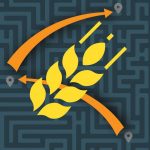
Sukhwinder Singh, head of the wheat portfolio at SeeD, meets with Ph.D. student Lourdes Ledesma and Ernesto Solis of INIFAP’s Mexico Wheat Research Program for el Bajio in Guanajuato, Mexico to evaluate bread wheat seed trials. Photo: SeeD.
The genetic diversity conserved in wheat genebanks around the world represents the genetic heritage of wheat, its progenitors and wild relatives. The conserved collections potentially harbor many undiscovered genes, alleles and/or haplotypes that yet have to be harnessed for wheat improvement.
In the Wheat component of SeeD we systematically explore the genetic richness of wheat to enable the targeted broadening of the genetic base of wheat breeding programs. We are working towards the following three interrelated objectives, each comprising a group of well-defined outputs:
- Objective 1: Build a molecular atlas for wheat. We are using a sequence based genotyping approach, DArTseq, that scores both SNP and PAV polymorphisms to quantify genetic relationships amongst genebank accessions with minimum ascertainment bias. One phenotypically representative individual per accession is genotyped, and seed from the genotyped individual are harvested for subsequent multiplication and refined phenotypic analyses for association-mapping applications (Objective 2). The resulting collection of genome profiles of accessions and breeding materials from the genebanks at CIMMYT and ICARDA, along with links to existing passport and characterization/evaluation data, are and will continue to be represented in a searchable ‘Wheat Molecular Atlas’. The objective also includes the generation and characterization of new bread wheat synthetics to mobilize unused progenitor diversity into the primary genepool.

Trial to screen for phosphorus efficiency, coordinated by Ivan Ortiz-Monasterio (CIMMYT). Photo: CIMMYT.
- Objective 2: Identify promising accessions and beneficial loci/alleles. In this objective, we evaluate genebank accessions for a set of priority traits (breeding targets) to (a) sample accessions into trait-specific subsets and association-mapping panels and (b) to identify promising ‘donor accession’ for trait mobilization. Depending on the trait, varying numbers of accessions are being evaluated in the field. Given the importance of heat and drought tolerance, the majority of CIMMYT’s genebank accessions are being evaluated for these traits. Association mapping will focus on panels assembled from the descents of genotyped individuals, selected based on genetic relationships and trait values measured at the whole-accession level.
- Objective 3: Develop wheat bridging germplasm. The final objective harnesses and combines outputs of the first two, to develop (a) a ‘linked topcross panel’ (LTP) of fixed lines, which contain a diverse representation of exotic alleles in elite genetic backgrounds for penetrance testing, joint linkage/association-mapping applications and trait mobilization into breeding programs, and (b) a recurrent introgressive population to capture and enrich beneficial small-effect alleles from different exotic accessions in a predominately elite background. The two kinds of ‘bridging germplasm’ will be made available to breeders, along with information about identified marker-trait associations and genomic estimates of breeding values to facilitate downstream introgression efforts.
To stimulate innovation and crowdsourcing-based data mining, all wheat datasets and attribution information will be made publicly available via the Wheat Molecular Atlas no later than 24 months after their generation (so that those who generated the data have an opportunity to draft scientific publications to add value to the data).
For more information please contact us at: seed@masagro.org















